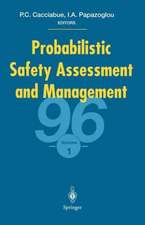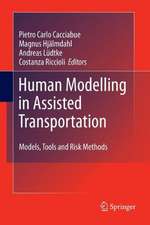Modelling Driver Behaviour in Automotive Environments: Critical Issues in Driver Interactions with Intelligent Transport Systems
Editat de Carlo Cacciabueen Limba Engleză Paperback – 13 oct 2010
This book presents a general overview of various factors that contribute to modelling human behaviour in a DVE. In practice, it is rare that all of these aspects have to be considered in total by a designer or safety analyst. However, they all contribute to creating the overall picture of the DVE model, and show the scope and dimensions of the many different interaction process that may take place and demand modelling consideration.
This long-awaited volume written by experts in the field presents state-of-the-art research and case studies. It will be invaluable reading for graduate students, researchers and professional practitioners alike.
| Toate formatele și edițiile | Preț | Express |
|---|---|---|
| Paperback (1) | 994.92 lei 6-8 săpt. | |
| SPRINGER LONDON – 13 oct 2010 | 994.92 lei 6-8 săpt. | |
| Hardback (1) | 998.87 lei 6-8 săpt. | |
| SPRINGER LONDON – 26 apr 2007 | 998.87 lei 6-8 săpt. |
Preț: 994.92 lei
Preț vechi: 1243.64 lei
-20% Nou
Puncte Express: 1492
Preț estimativ în valută:
190.40€ • 198.05$ • 157.19£
190.40€ • 198.05$ • 157.19£
Carte tipărită la comandă
Livrare economică 14-28 aprilie
Preluare comenzi: 021 569.72.76
Specificații
ISBN-13: 9781849966283
ISBN-10: 1849966281
Pagini: 428
Ilustrații: XIV, 428 p. 148 illus.
Dimensiuni: 155 x 235 x 23 mm
Greutate: 0.64 kg
Ediția:Softcover reprint of hardcover 1st ed. 2007
Editura: SPRINGER LONDON
Colecția Springer
Locul publicării:London, United Kingdom
ISBN-10: 1849966281
Pagini: 428
Ilustrații: XIV, 428 p. 148 illus.
Dimensiuni: 155 x 235 x 23 mm
Greutate: 0.64 kg
Ediția:Softcover reprint of hardcover 1st ed. 2007
Editura: SPRINGER LONDON
Colecția Springer
Locul publicării:London, United Kingdom
Public țintă
ResearchCuprins
International Projects and Actions on Driver Modelling.- Modelling Driver Behaviour in European Union and International Projects.- TRB Workshop on Driver Models: A Step Towards a Comprehensive Model of Driving?.- Towards Monitoring and Modelling for Situation-Adaptive Driver Assist Systems.- Conceptual Framework and Modelling Architectures.- A General Conceptual Framework for Modelling Behavioural Effects of Driver Support Functions.- Modelling the Driver in Control.- From Driver Models to Modelling the Driver: What Do We Really Need to Know About the Driver?.- Learning and Behavioural Adaptation.- Subject Testing for Evaluation of Driver Information Systems and Driver Assistance Systems — Learning Effects and Methodological Solutions.- Modelling Driver’s Risk Taking Behaviour.- Dealing with Behavioural Adaptations to Advanced Driver Support Systems.- Modelling Motivation and Psychological Mechanisms.- Motivational Determinants of Control in the Driving Task.- Towards Understanding Motivational and Emotional Factors in Driver Behaviour: Comfort Through Satisficing.- Modelling Driver Behaviour on Basis of Emotions and Feelings: Intelligent Transport Systems and Behavioural Adaptations.- Modelling Risk and Errors.- Time-Related Measures for Modelling Risk in Driver Behaviour.- Situation Awareness and Driving: A Cognitive Model.- Driver Error and Crashes.- Control Theory Models of Driver Behaviour.- Control Theory Models of the Driver.- Review of Control Theory Models for Directional and Speed Control.- Simulation of Driver Behaviour.- Cognitive Modelling and Computational Simulation of Drivers Mental Activities.- Simple Simulation of Driver Performance for Prediction and Design Analysis.- Simulation of Traffic and Real Situations.- Real-Time Traffic and EnvironmentRisk Estimation for the Optimisation of Human-Machine Interaction.- Present and Future of Simulation Traffic Models.
Recenzii
From the reviews:
"Thirty-seven authors contribute 21 papers to this book. … They provide a multifaceted description of driver-behavior modeling based on their expertise in different fields, and the state of the art in this field is described from many perspectives. … The book presents a comprehensive overview of topics for development and open issues characterizing potential new research. It is intended for researchers and practitioners; managers will also find the book useful." (O. Balci, ACM Computing Reviews, September, 2008)
"Thirty-seven authors contribute 21 papers to this book. … They provide a multifaceted description of driver-behavior modeling based on their expertise in different fields, and the state of the art in this field is described from many perspectives. … The book presents a comprehensive overview of topics for development and open issues characterizing potential new research. It is intended for researchers and practitioners; managers will also find the book useful." (O. Balci, ACM Computing Reviews, September, 2008)
Notă biografică
Carlo Cacciabue is an internationally-renowned expert on safety-critical systems and accident investigation, and an experienced consultant. He is a senior scientist in the Institute for the Protection and Security of the Citizen, at the Joint Research Centre of the European Commission, Ispra, Italy.
He holds a PhD in Nuclear Engineering from the Politecnico di Milano (Italy) and retains a number of temporary academic positions in Italian and European universities.
He is the author of two monographs and of several publications in journals and books relating to safety engineering and human-machine interaction in the domains of energy production and transportation.
He is the principal Editor, together with E. Hollnagel, of Springer's International Journal of Cognition, Technology & Work.
He holds a PhD in Nuclear Engineering from the Politecnico di Milano (Italy) and retains a number of temporary academic positions in Italian and European universities.
He is the author of two monographs and of several publications in journals and books relating to safety engineering and human-machine interaction in the domains of energy production and transportation.
He is the principal Editor, together with E. Hollnagel, of Springer's International Journal of Cognition, Technology & Work.
Textul de pe ultima copertă
The study of all technological systems, in terms of design, safety assessment or training purposes requires that significant attention is dedicated to the human perspective. Techniques for user-centred design are normally applied and exploited before implementing new control devices or safety systems that are managed by a human user or operator. This demands that appropriate models of Human Machine Interaction and associated taxonomies for classifying human behaviour are available for theoretical and practical application.
In the automotive environment, the paradigm of the joint human-machine system is called the "Driver-Vehicle-Environment" (DVE) model. Several studies have pointed out the unique nature of this domain, which can refer the standardisation and normalisation of behaviours, contexts and technology.
This book presents a general overview of the various factors that contribute to modelling human behaviour in this specialised environment. All of these aspects contribute to creating the overall picture of the DVE model, and demonstrate the scope and dimensions of the many different interaction processes that demand modelling consideration.
This long-awaited volume, written by world experts in the field, presents state-of-the-art research and case studies. It will be invaluable reading for professional practitioners graduate students, researchers and alike.
Pietro Carlo Cacciabue is a senior scientist at the Institute for the Protection and Security of the Citizen, within the Joint Research Centre of the European Commission, Ispra, Italy. He is the author of two monographs and several book and journal publications relating to safety engineering and human-machine interaction in the domains of energy production and transportation. He is the principal Editor, together with Erik Hollnagel, of The International Journal of Cognition, Technology & Work.
In the automotive environment, the paradigm of the joint human-machine system is called the "Driver-Vehicle-Environment" (DVE) model. Several studies have pointed out the unique nature of this domain, which can refer the standardisation and normalisation of behaviours, contexts and technology.
This book presents a general overview of the various factors that contribute to modelling human behaviour in this specialised environment. All of these aspects contribute to creating the overall picture of the DVE model, and demonstrate the scope and dimensions of the many different interaction processes that demand modelling consideration.
This long-awaited volume, written by world experts in the field, presents state-of-the-art research and case studies. It will be invaluable reading for professional practitioners graduate students, researchers and alike.
Pietro Carlo Cacciabue is a senior scientist at the Institute for the Protection and Security of the Citizen, within the Joint Research Centre of the European Commission, Ispra, Italy. He is the author of two monographs and several book and journal publications relating to safety engineering and human-machine interaction in the domains of energy production and transportation. He is the principal Editor, together with Erik Hollnagel, of The International Journal of Cognition, Technology & Work.
Caracteristici
Long-awaited, as the last best-known books containing recent results, tendencies and paradigms were in 1985 and 1993 An important and wide reaching tightly-edited volume involving a diverse range of disciplines where in particular human factors, behavioural modelling, ergonomics, and psychology play an important role The authors are world class experts in the field – this could be the authoritative text on this topic










